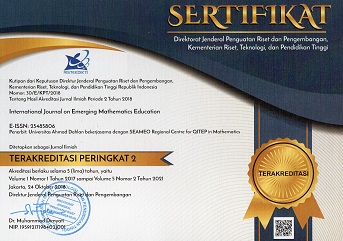The Characteristics of Four-Tier Diagnostic Test: Classical Test Theory Perspective
Abstract
This study is part of developing a four-tier online diagnostic test for geometry in junior high schools in Indonesia. After wrote the items and validated by experts, items were tested on 249 students in Yogyakarta, one of the Special Regions in Indonesia. This study aims to identify the characteristics of a four-tier online diagnostic test, from a classical test theory (CTT) perspective. This test contains 20 items of four-tier multiple choice with four options. The students’ responses were analyzed using Item and Test Analysis (ITEMAN) package. Item difficulty index, discriminant index, and reliability coefficient were three attributes analyzed. The average of item difficulty index is 0.384 (moderate category). The average item discriminant index is 0.513 (good category). The estimation of the reliability coefficient using the Cronbach-Alpha formula is 0.706 (good category).
Keywords
Full Text:
PDFReferences
Aliustaoglu, F., Tuna, A., & Biber, A. C. (2018). Misconceptions of sixth grade secondary school students on fractions. International Electronic Journal of Elementary Education, 10(5), 591–599. https://doi.org/10.26822/iejee.2018541308
Anggrayni, S., & Ermawati, F. U. (2019). The validity of Four-Tier’s misconception diagnostic test for Work and Energy concepts. Journal of Physics: Conference Series, 1171(1). https://doi.org/10.1088/1742-6596/1171/1/012037
Aydin, S., Keles, U., & Hasiloglu, A. (2012). Establishment for misconceptions that science teacher candidates have about geometric optics. The Online Journal of New Horizons in Education, 2(3), 7–15.
Caleon, I., & Subramaniam, R. (2010). Development and application of a three-tier diagnostic test to assess secondary students’ understanding of waves. International Journal of Science Education, 32(7), 939–961. https://doi.org/10.1080/09500690902890130
Dhakne-Palwe, S., Gujarathi, A., & Almale, B. (2015). Item Analysis of MCQs and Correlation between Difficulty Index, Discrimination Index and Distractor Efficiency in a Formative Examination in Community Medicine. Journal of Research in Medical Education & Ethics, 5(3), 254–259. https://doi.org/10.5958/2231-6728.2015.00052.9
Diani, R., Alfin, J., Anggraeni, Y. M., Mustari, M., & Fujiani, D. (2019). Four-Tier Diagnostic Test with Certainty of Response Index on the Concepts of Fluid. Journal of Physics: Conference Series, 1155(1). https://doi.org/10.1088/1742-6596/1155/1/012078
Fariyani, Q., Rusilowati, A., & Sugianto, S. (2017). Four-Tier Diagnostic Test To Identify Misconceptions in Geometrical Optics. Unnes Science Education Journal, 6(3), 1724–1729. https://doi.org/10.15294/usej.v6i3.20396
Fernandes, H. J. X. (1984). Testing and Measurement. Jakarta: Planning, Evaluation, and Development.
Flevares, L. M., & Schiff, J. R. (2014). Learning mathematics in two dimensions: A review and look ahead at teaching and learning early childhood mathematics with children’s literature. Frontiers in Psychology, 5(May), 1–13. https://doi.org/10.3389/fpsyg.2014.00459
Gooding, J., & Metz, B. (2011). From Misconceptions to Conceptual Change: Tips for identifying and overcoming students’ misconceptions. The Science Teacher, (April/May), 34–37.
Kula, S., & Güzel, E. B. (2014). Misconceptions emerging in mathematics student teachers’ limit instruction and their reflections. Quality and Quantity, 48(6), 3355–3372. https://doi.org/10.1007/s11135-013-9961-y
Kusmaryono, I., Basir, M. A., & Saputro, B. A. (2020). Ontological Misconception in Mathematics. Infinity, 9(1), 15–30.
Mohyuddin, R. G., & Khalil, U. (2016). Misconceptions of students in learning mathematics at primary level. Bulletin of Education and Research, 38(1), 133–162.
Muijs, R. D., & Reynolds, D. (2005). Effective Teaching. Evidence and Practice. (2nd ed.). Paul Chapman Publishing Ltd.
Musa, A., Shaheen, S., & Elmardi, A. (2018). Item difficulty & item discrimination as quality indicators of physiology MCQ examinations at the Faculty of Medicine Khartoum University. Khartoum Medical Journal, 11(2), 1477–1468.
Ojose, B. (2015). Students’ Misconceptions in Mathematics: Analysis of Remedies and What Research Says. Ohio Journal of School Mathematics, 72(Fall), 30–34.
Özerem, A. (2012). Misconceptions In Geometry And Suggested Solutions For Seventh Grade Students. Procedia - Social and Behavioral Sciences, 55, 720–729. https://doi.org/10.1016/j.sbspro.2012.09.557
Prabowo, A., Anggoro, R. P., Rahmawati, U., & Rokhima, N. (2019). Android-based teaching material for straight-sides solid. Journal of Physics: Conference Series, 1321(3). https://doi.org/10.1088/1742-6596/1321/3/032097
Ravand, H., & Baghaei, P. (2020). Diagnostic Classification Models: Recent Developments, Practical Issues, and Prospects. International Journal of Testing, 20(1), 24–56. https://doi.org/10.1080/15305058.2019.1588278
Retnawati, H., Arlinwibowo, J., & Sulistyaningsih, E. (2017). The Students’ Difficulties in Completing Geometry Items of National Examination. International Journal on New Trends in Education and Their Implications, 8(4), 28–41. Retrieved from https://ci.nii.ac.jp/naid/40021243259/
Reynolds, C. R., Livingston, R. B., & Willson, V. (2010). Measurement and assessment in education (2nd ed.). New Jersey: Pearson Education.
Roselizawati, Sarwadi, & Shahril, M. (2014). Understanding Students’ Mathematical Errors and Misconceptions: The Case of Year 11 Repeating Students. Mathematics Education Trends and Research, 2014(June), 1–10. https://doi.org/10.5899/2014/metr-00051
Shim, G. T. G., Shakawi, A. M. H. A., & Azizan, F. L. (2017). Relationship between Students’ Diagnostic Assessment and Achievement in a Pre-University Mathematics Course. Journal of Education and Learning, 6(4), 364–371. https://doi.org/10.5539/jel.v6n4p364
Sundaygara, C., Gusi, L. A. R. P., Pratiwi, H. Y., Ayu, H. D., Jufriadi, A., & Hudha, M. N. (2021). Identification students’ misconception using four-tier diagnostic test on Newton Law subject. Journal of Physics: Conference Series, 1869(1). https://doi.org/10.1088/1742-6596/1869/1/012157
Traub, R. E. (1997). Classical test theory in historical perspective. Educational Measurement: Issues and Practice, 16(4), 8–14. https://doi.org/10.1111/j.1745-3992.1997.tb00603.x
DOI: http://dx.doi.org/10.12928/ijeme.v7i1.22677
Refbacks
- There are currently no refbacks.
Copyright (c) 2023 Anggit Prabowo, Tatang Herman, Siti Fatimah

This work is licensed under a Creative Commons Attribution-ShareAlike 4.0 International License.
International Journal on Emerging Mathematics Education
Kampus 2 Universitas Ahmad Dahlan
Jalan Pramuka No. 42, Pandeyan, Umbulharjo, Yogyakarta - 55161
Telp. (0274) 563515, ext. 4902; Fax. (0274) 564604
Email: ijeme@uad.ac.id
p-ISSN: 2549-4996 | e-ISSN: 2548-5806
This work is licensed under a Creative Commons Attribution 4.0 International License

